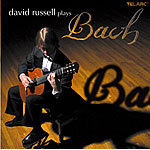
David Russell Plays Bach
 $33.29
Out of Stock
$33.29
Out of Stock6+ weeks add to cart
J.S. BACH
David Russell Plays Bach
David Russell (guitar)
[ Telarc Records / CD ]
Release Date: Sunday 2 March 2003
This item is currently out of stock. It may take 6 or more weeks to obtain from when you place your order as this is a specialist product.
Today, more than two and a half centuries after Bach's passing, lute players are all but extinct—even in classical music circles. But the guitar, a direct descendant of the lute, is still highly regarded as a classical instrument. And David Russell is considered one of the best classical guitarists in the world. This high ranking makes David Russell Plays Bach, the world-renowned guitarist's latest recording on Telarc, an extraordinary listening experience.
Johann Sebastian Bach was one of the greatest keyboard players of his day, "admired by all who had the good fortune to hear him, the envy of the virtuosi of his day," according to early Bach biographer Johann Forkel. But he was also a skilled performer on other instruments, including the violin, cello and lute.
Today, more than two and a half centuries after Bach's passing, lute players are all but extinct—even in classical music circles. But the guitar, a direct descendant of the lute, is still highly regarded as a classical instrument. And David Russell is considered one of the best classical guitarists in the world. This high ranking makes David Russell Plays Bach (CD-80584), the world-renowned guitarist's latest recording on Telarc, an extraordinary listening experience. In this recital, Russell translates some of Bach's finest music for lute, violin and keyboard into the compelling sonic world of the guitar.
The opening tracks—Bach's Prelude, Fugue and Allegro—were most likely inspired by Sylvius Leopold Weiss, Bach's close friend and the most renowned lutenist of the day. The work's three sections comprise a virtual stylistic catalog of the principal manners of lute-playing.
The Partita No. 2 was arranged by Russell from the D Minor Partita for Solo Violin, one of the three partitas for unaccompanied violin that Bach wrote around 1720, while he was director of music at the court of Anhalt-Cothen, north of Leipzig. It follows the customary order of dance movements for the baroque suite: Allemande, Courante, Sarabande and Gigue—all of which serve as a preface to the wondrous closing Chaconne, one of Bach's most sublime compositions.
The Lute Suite No. 4, Bach's transcription of the E minor Partita for Solo Violin, opens with a brilliant Preludio, and is followed by a series of dances in bright tempos. Immediately following the suite is the finale, a 1641 chorale melody by Johann Schop, with a text by Johann Rist—a widely recognized piece that has come to be known as Jesu, Joy of Man's Desiring.
A gifted and brilliant musician since his childhood in Glasgow, Scotland, David Russell is recognized the world over for his superb musicianship and inspired artistry, having earned the highest praise from audiences and critics alike. In recognition of his great talent, the Royal Academy of Music in London named him a Fellow in 1997.
In the midst of a consistently ambitious tour schedule that takes him to virtually every corner of the globe, Russell participates in classical guitar festivals and teaches master classes. He is a favorite on college campuses because of his special interest in advancing young people's interest in music, and specifically in providing opportunities for classical guitarists at all levels.
Tracks:
Prelude, Fugue and Allegro, BWV 998
1. Prelude
2. Fugue
3. Allegro
Chorale Prelude, "Wachet auf, ruft uns die Stimme," BWV 645
Partita No. 2, BWV 1004
Allemande
Courante
Sarabande
Gigue
Chaconne
Suite No. 4 for Lute, BWV 1006a
Preludio
Loure
Gavotte en Rondeau
Menuets I and II
Bourree
Gigue
Chorale Prelude, "Jesu, Joy of Man's Desiring"



